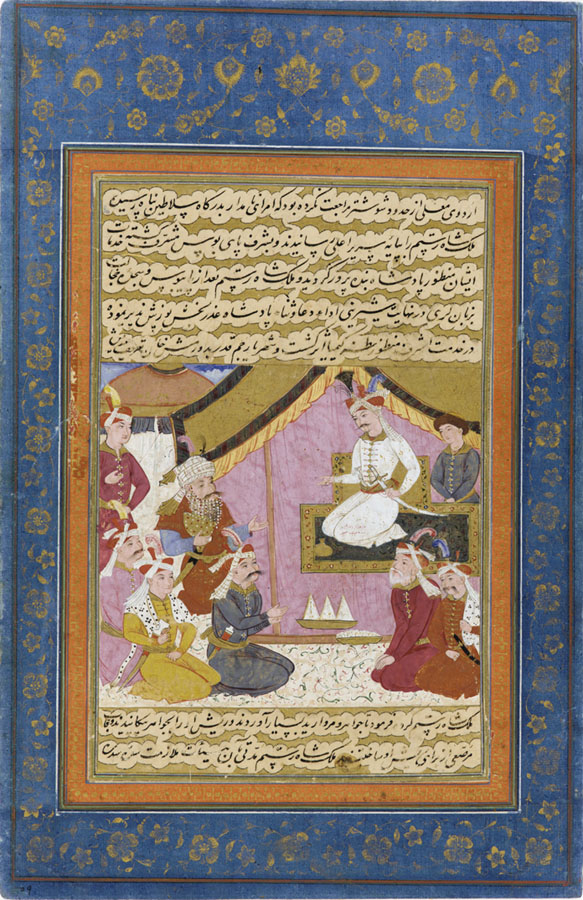Location: Art and History Trust, on deposit at the Arthur M. Sackler Gallery, Smithsonian Institution, Washigton D.C., LTS1995.2.175
Mount: blue mount 36.0 x 23.3 cm; orange collar.
Written surface: 24.5 x 15.7 cm.
Painting: 14.3 x 15.7 cm.
Text references: J.K., p.298 line 8 to p.299 line 2.
See also Savory, SA_1979, pp. 56-57 for this event in the History of Shah ʿĀbbās.
Date of this event: 914/1508.
The place was on the borders of Lorestan. After dealing with affairs in Arab Iraq, Esmāʿil marched on Khuzestan to subjugate that province. On the border of Lorestan, he detached a force of 10,000 under Ḥoseyn Beg Lāla Šāmlu and Beyrām Beg Qarāmānlu, and dispatched them against Malek Shah Rostam, the ruler of Lorestan. Malek fled before the Safavid forces and took refuge in a mountainous region. The emirs surrounded the mountain, and his situation became desperate. He approached the emirs, and on promise of quarter and in their company went to the royal court, where he uttered sweet words in the Lori dialect and pledged his loyalty to the shah. In turn Esmāʿil presented him with a golden vessel inlaid with jewels for his beard. Malek Rostam spent some time with the shah, and was then reinstated as the governor of Lorestan.
Cf. ms. L, f. 149v and ms. M, SE_179 for two other version of this subject. This composition is similar to the two others cited, and varies primarily as the result of a different space alotted to it. ms. L, f. 149v painting is a vertical rectangle; this painting is almost a square, slightly wider than it is high; while ms. M, SE_179 is somewhere between the two. Nine figures - Esmāʿil, six qezelbāš, an attendant, and Malek Shah are represented. That the three versions are derived from one another, or from a common source, is attested to by small detail, such as the dish with three objects just before the shah, which are exactly the same in all three variants.
Esmāʿil is seated on a throne, shown in plan and elevation simultaneously, in the upper right, inside a tent. He wears a white coat and a flat top Safavid tāj with insignia of his office. To the right is the ceremonial sword bearer. All of the remaining personage are qezelbāš: two seated in the lower right, and four more surrounding Malek Shah. Two of the qezelbāš - the ones with leopard skin capes - may be Ḥoseyn Beg Lāla Šāmlu and Beyrām Beg Qarāmānlu, who according to the text were present. Malek Shah Rostam, virtually insulated from the shah by qezelbāš, wears a turban, a jewel encrusted beard, and holds a bejeweled gold vessel, reportedly a covering for his beard, that was given to him by the shah. Behind him, on the left stands his ceremonial swordbearer.
Inscriptions:
On the knee of the Shah: identifies him as Shah Esmāʿil
On the arm of seated bearded figure in red: Malek Shah Rostam
Another, illegible inscription, appears on the tent to the left of Esmāʿil. There is neither a date nor signature.
Painting references:
Sotheby’s New York, 30 June 1980, Lot 243A (ill.).
Soudovar, PC_1992, #115 (ill. in color).
Photo: The Art and History Collection, courtesy of the Arthur M. Sackler Gallery, Smithsonian Institution, Washigton D.C.
Robert Eng
Last Updated: August 15, 2011 | Originally published: August 15, 2011
